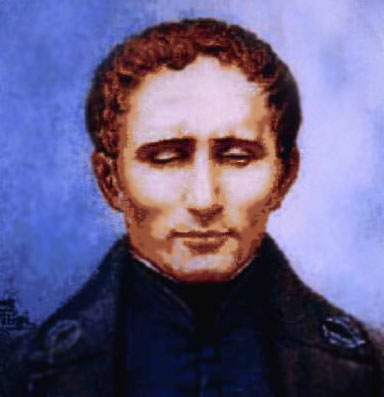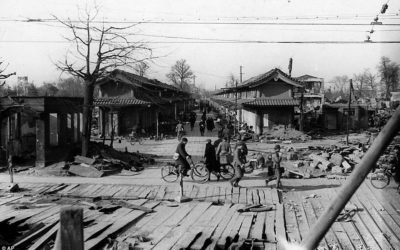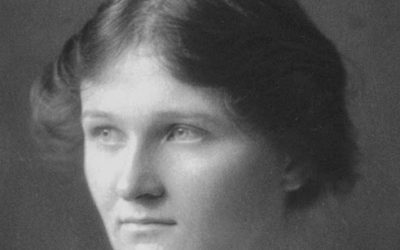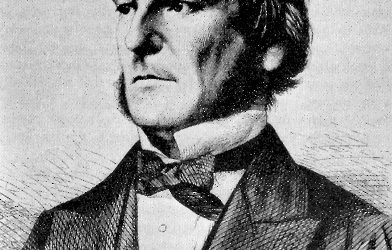One of the greatest underappreciated advantages that most of us possess is access to the written words of others. Alphabets, printing and widespread literacy combine to let us experience times, places and sentiments other than our own and face our daily problems with the knowledge of millennia at our disposal. Without these things, none of the stories we’ve discussed in this series would exist; they would have faded away with the lives of our Achievers and the memories of those who knew them.
Alphabets are so fundamental to literacy that most of the ones currently used were
invented in the far distant past, with no known inventor. Among the few exceptions to this rule we can count Hangul, attributed to a 15th-century king of Korea, the Cherokee script developed by Sequoyah, and perhaps most impressive of all, the system of raised bumps known as Braille. What makes Braille stand out from other alphabets is the far-reaching vision of its creator, Louis Braille, a blind man who was painfully aware of the knowledge denied to him by his disability and determined to transcend it through an alphabet that would enable him and others like him to read and write effectively.
Louis Braille was born fully sighted in the small French town of Coupvray in 1809. His father was a prosperous leather worker, and young Louis often played in the family workshop. One day, when he was three years old, he was trying to poke a hole in a piece of leather with an awl when the tool rebounded off the leather and cut him across the eye. He was taken immediately to a nearby doctor, but nothing could be done to save it; in fact, it developed a severe infection that quickly spread to his other eye. By the age of five, he was completely blind.
Braille’s parents worked hard to make his life as normal as possible. His father carved canes for him so that he could learn to walk around his village. To make the most of his brilliant mind, his parents arranged for him to attend one of the first schools for the blind, the Royal Institute for Blind Youth in Paris, starting at the age of 10. Here he was taught to read using a system invented by the school’s founder, by which normal Latin type was raised off the surface of a book’s pages so that the reader could trace it with a finger and interpret
the writing.
Regrettably, the system had many disadvantages for its users. For one, the books were heavy and awkward to hold because of the thick paper used in their construction. Also, because the letters were raised using a complex artisanal technique, they were expensive to produce, and there was always a short supply of them. Finally, and most crushingly, the blind students could never hope to write using the system themselves; it was so complicated that only a fully sighted person could do it. Braille was only able to write letters home thanks to a set of leather alphabet stencils that his parents had sent him, which he used to laboriously trace out sentences one letter at a time.
However, this was soon to change. Only two years after he joined the school, Braille learned of a “night writing” alphabet invented by Captain Charles Barbier of the French army. Barbier had developed a system of raised dots and dashes that soldiers in the field could use to communicate at night without giving away their position by speaking or lighting a match. Although Barbier never put his system into effect, the 12-year old Braille was inspired, and he realized that a similar alphabet could be of immense help to him and his fellow students.
Three years later, in 1824, his system was essentially complete, and by 1829 he had published it. Ironically, he used an awl, the same tool that had cut him off from ordinary literacy, to punch the raised dots that would form his new alphabet.
Because a blind man had developed it, Braille’s system was far more sensitive to the needs of the blind than its predecessors. He simplified Barbier’s night-writing by reducing the number of dots used, eliminating dashes as an unnecessary complication, and most crucially, reducing the size of the “letters” so that each could be read with a single touch of one finger. Blind students could not only read these letters easily, but with a few simple tools they could write it fluently as well. Bridging the gap between the sighted and sightless even further, in 1839 Braille published a system he called “decapoint,” by which blind writers could consistently produce readable text in French. For the first time, the blind could use the written word not only among themselves, but in the wider community.
While pursuing these innovations, Braille stayed at the school where he had received his education, first as a teacher’s aide and then as a full professor, teaching history, geometry and algebra to a new generation of blind students. He was also an accomplished musician who had the opportunity to play church organs throughout France, and he adapted his Braille system to represent musical notation as well as the Latin alphabet.
The Braille alphabet, though it was popular with his students, was not officially adopted by schools for the blind during his lifetime; it was too radical an innovation for these generally conservative institutions to embrace. But two years after his death, in 1854, the Royal Institute for Blind Youth was driven by the insistence of its students to begin teaching it, and the system began to spread across France. By the late 19th century, Braille was a common
feature in curriculums for the blind in most of Europe, and by 1916 its use was nearly universal in the United States as well. Underappreciated in his lifetime, Louis Braille became a household name just half a century later.
Far fewer blind students learn Braille today compared to only a few decades ago, due to several contributing factors: the decline of traditional schools for the blind, the rise of alternatives like audiobooks and voice-recognition software, and a widespread attitude that Braille is outdated. However, studies have shown that blind students who know Braille, like fully sighted children who read recreationally, have a better shot at educational and professional success. And when blind readers feel like and diving into the world of writing, Louis
Braille’s alphabet will be there waiting for them.
Next Post: Charles Martin Hall, Julia Brainerd Hall, and Paul Héroult, the young adults who discovered the “Hall-Héroult” refining process that transformed aluminum from a costly luxury to a staple of everyday life.














